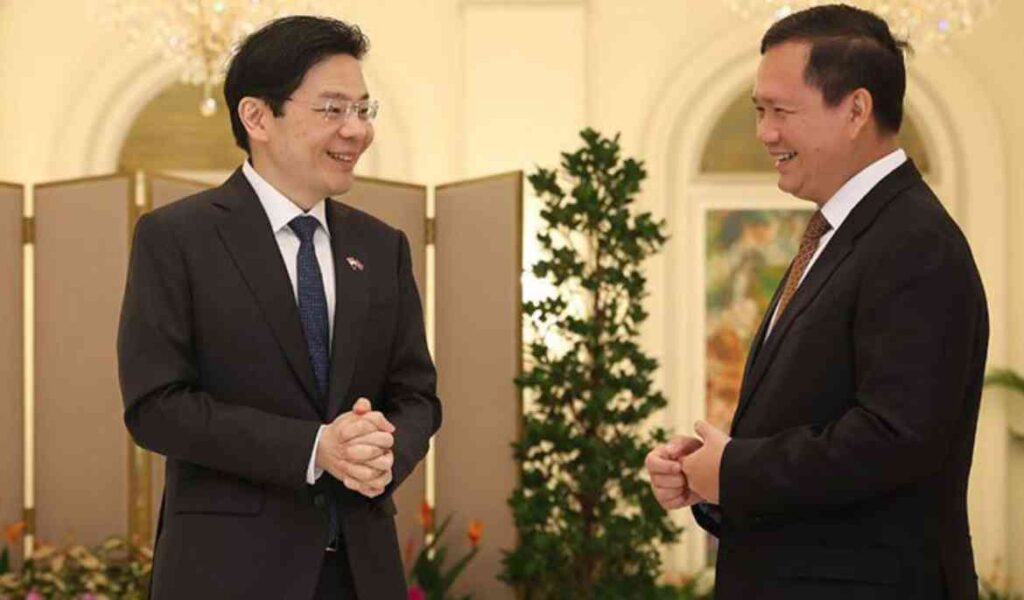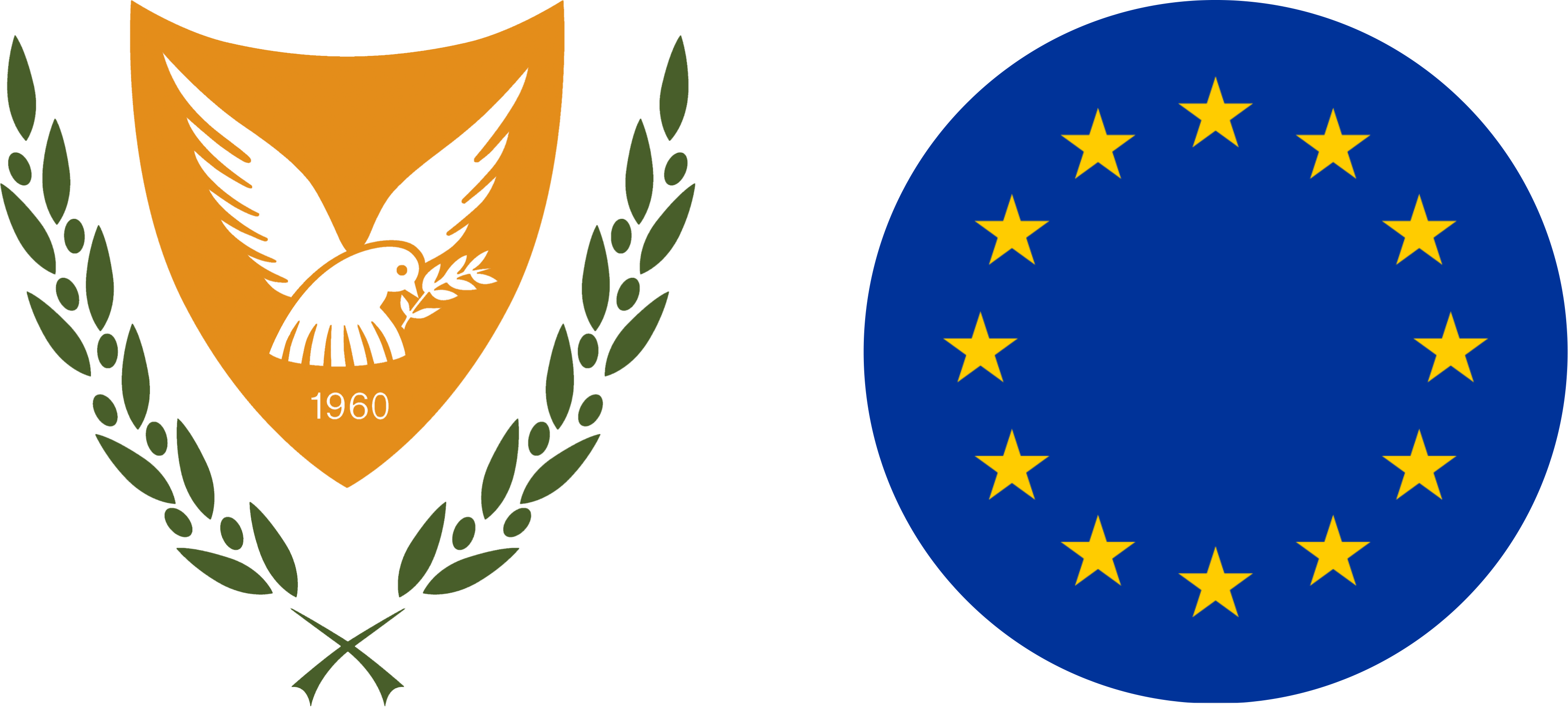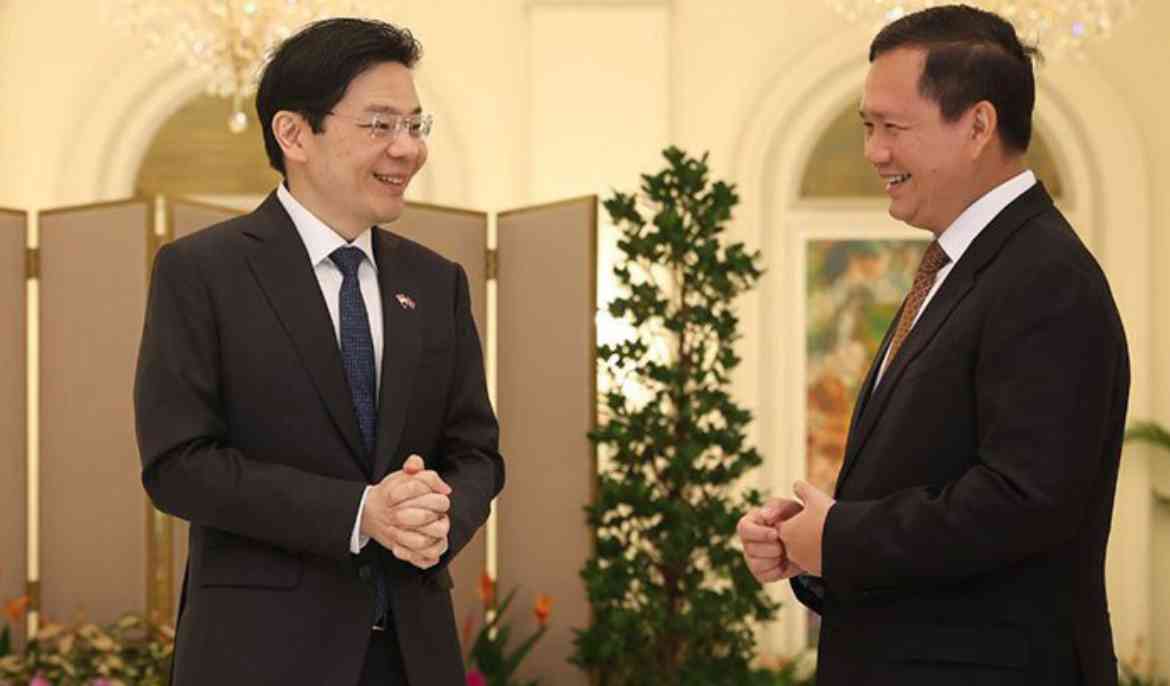Both countries are entering a new era, one built on mutual trust, shared prosperity, and common regional objectives.
As Cambodia and Singapore mark 60 years of diplomatic relations this year, the two nations are taking bold steps toward a shared digital future. What began as a celebration of long-standing friendship has evolved into a roadmap for regional digital transformation, trade facilitation, and human capital development.
Singaporean Prime Minister Lawrence Wong’s official visit to Phnom Penh on July 2 underscored the maturity and depth of the relationship. Yet, it wasn’t the commemorative speeches or the photo sessions that stood out, it was the concrete steps both governments are taking to integrate their digital systems, strengthen public sector innovation, and expand economic collaboration across borders.
The focus on digital cooperation is not accidental. It reflects a growing recognition that economic competitiveness in Southeast Asia will increasingly depend on digital infrastructure, smart governance, and skilled talent.
In a joint statement, both governments welcomed the growing partnership in digital development. At the centre of this collaboration is a Memorandum of Understanding signed between Cambodia’s Ministry of Post and Telecommunications (MPTC) and Singapore’s Ministry of Communications and Information (MCI).
Signed in June last year by MPTC Minister Chea Vandeth and Dr Janil Puthucheary, Minister-in-charge of GovTech Singapore, the MoU sets the stage for cooperation in both technical reforms and human capital development.
A series of digital tools originally developed by Singapore’s Open Government Products division have since been adapted for Cambodian use. These include VerifyKH, a certificate authentication system; Form.gov.kh, an electronic form builder; Go.gov.kh, a secure URL shortener; Flow.gov.kh, a no-code automation tool for public service processes; and Nomsa.gov.kh, a mass messaging system for government agencies.
According to the Ministry of Post and Telecommunications, the localised tools are already improving how Cambodians interact with state institutions, enhancing transparency, efficiency, and accessibility. More importantly, they are helping lay the groundwork for digital trust.
https://googleads.g.doubleclick.net/pagead/ads?client=ca-pub-7981514788931893&output=html&h=280&slotname=4059842397&adk=3582013211&adf=1835184027&pi=t.ma~as.4059842397&w=750&abgtt=6&fwrn=4&fwrnh=100&lmt=1754633396&rafmt=1&format=750×280&url=https%3A%2F%2Fwww.khmertimeskh.com%2F501734597%2Fcambodia-singapore-chart-a-digital-future-together%2F&fwr=0&rpe=1&resp_fmts=3&wgl=1&uach=WyJXaW5kb3dzIiwiMTkuMC4wIiwieDg2IiwiIiwiMTM4LjAuMzM1MS4xMjEiLG51bGwsMCxudWxsLCI2NCIsW1siTm90KUE7QnJhbmQiLCI4LjAuMC4wIl0sWyJDaHJvbWl1bSIsIjEzOC4wLjcyMDQuMTg0Il0sWyJNaWNyb3NvZnQgRWRnZSIsIjEzOC4wLjMzNTEuMTIxIl1dLDBd&dt=1754635180463&bpp=1&bdt=493&idt=87&shv=r20250805&mjsv=m202508050101&ptt=9&saldr=aa&abxe=1&cookie=ID%3D67e34bb3c3602a99%3AT%3D1748239820%3ART%3D1754635021%3AS%3DALNI_MZ9WnYJRvq0wQnr0ABvgb3yZ2dV8A&gpic=UID%3D000010e82a43ea78%3AT%3D1748239820%3ART%3D1754635021%3AS%3DALNI_Mb_jT4JgIj9bmfHlQDXDXo08Q6xUw&eo_id_str=ID%3D8acbd9ed3bbf4ae5%3AT%3D1748239820%3ART%3D1754635021%3AS%3DAA-AfjajqdsfBH648tM7O872ou0M&prev_fmts=0x0%2C750x280%2C750x280&nras=1&correlator=8104026435236&frm=20&pv=1&u_tz=420&u_his=1&u_h=1080&u_w=1920&u_ah=1032&u_aw=1920&u_cd=24&u_sd=0.8&dmc=8&adx=616&ady=2694&biw=2371&bih=1192&scr_x=0&scr_y=0&eid=95362655%2C95367554%2C95344789%2C95359265&oid=2&pvsid=8123432835869145&tmod=1304436211&uas=0&nvt=1&ref=https%3A%2F%2Fwww.linkedin.com%2F&fc=1920&brdim=1537%2C1%2C1537%2C1%2C1920%2C0%2C1918%2C1030%2C2390%2C1192&vis=1&rsz=%7C%7CEebr%7C&abl=CS&pfx=0&fu=128&bc=31&bz=0.8&td=1&tdf=2&psd=W251bGwsbnVsbCxudWxsLDNd&nt=1&pgls=CAEQARoFNC44LjU.~CAEaBTYuOC4y~CAA.&ifi=4&uci=a!4&btvi=2&fsb=1&dtd=90
https://googleads.g.doubleclick.net/pagead/ads?client=ca-pub-7981514788931893&output=html&h=280&slotname=4059842397&adk=626518189&adf=2769442277&pi=t.ma~as.4059842397&w=750&abgtt=6&fwrn=4&fwrnh=100&lmt=1754633396&rafmt=1&format=750×280&url=https%3A%2F%2Fwww.khmertimeskh.com%2F501734597%2Fcambodia-singapore-chart-a-digital-future-together%2F&fwr=0&rpe=1&resp_fmts=3&wgl=1&uach=WyJXaW5kb3dzIiwiMTkuMC4wIiwieDg2IiwiIiwiMTM4LjAuMzM1MS4xMjEiLG51bGwsMCxudWxsLCI2NCIsW1siTm90KUE7QnJhbmQiLCI4LjAuMC4wIl0sWyJDaHJvbWl1bSIsIjEzOC4wLjcyMDQuMTg0Il0sWyJNaWNyb3NvZnQgRWRnZSIsIjEzOC4wLjMzNTEuMTIxIl1dLDBd&dt=1754635180463&bpp=1&bdt=493&idt=94&shv=r20250805&mjsv=m202508050101&ptt=9&saldr=aa&abxe=1&cookie=ID%3D67e34bb3c3602a99%3AT%3D1748239820%3ART%3D1754635021%3AS%3DALNI_MZ9WnYJRvq0wQnr0ABvgb3yZ2dV8A&gpic=UID%3D000010e82a43ea78%3AT%3D1748239820%3ART%3D1754635021%3AS%3DALNI_Mb_jT4JgIj9bmfHlQDXDXo08Q6xUw&eo_id_str=ID%3D8acbd9ed3bbf4ae5%3AT%3D1748239820%3ART%3D1754635021%3AS%3DAA-AfjajqdsfBH648tM7O872ou0M&prev_fmts=0x0%2C750x280%2C750x280%2C750x280&nras=1&correlator=8104026435236&frm=20&pv=1&u_tz=420&u_his=1&u_h=1080&u_w=1920&u_ah=1032&u_aw=1920&u_cd=24&u_sd=0.8&dmc=8&adx=616&ady=2974&biw=2371&bih=1192&scr_x=0&scr_y=0&eid=95362655%2C95367554%2C95344789%2C95359265&oid=2&pvsid=8123432835869145&tmod=1304436211&uas=0&nvt=1&ref=https%3A%2F%2Fwww.linkedin.com%2F&fc=1920&brdim=1537%2C1%2C1537%2C1%2C1920%2C0%2C1918%2C1030%2C2390%2C1192&vis=1&rsz=%7C%7CEebr%7C&abl=CS&pfx=0&fu=128&bc=31&bz=0.8&td=1&tdf=2&psd=W251bGwsbnVsbCxudWxsLDNd&nt=1&pgls=CAEQARoFNC44LjU.~CAEaBTYuOC4y~CAA.&ifi=5&uci=a!5&btvi=3&fsb=1&dtd=98
“These technologies are not simply tools, they are enablers of a more accountable and citizen-friendly public service,” said a senior MPTC official. “They empower government officers and make public services faster and more reliable for ordinary Cambodians.”
Singapore’s support has also extended into Cambodia’s financial ecosystem. One of the most significant achievements in recent months has been the launch of the Financial Transparency Corridor (FTC) in June 2024. Initiated by the National Bank of Cambodia and Singapore’s Monetary Authority, the FTC is a cross-border financial infrastructure that aims to make financing easier for small and medium enterprises (SMEs).
Thong Mengdavid, a lecturer at the Royal University of Phnom Penh’s Institute for International Studies and Public Policy, told Khmer Times that the FTC holds long-term promise.
“The corridor is designed to improve credit assessments and enable more efficient cross-border financing for SMEs,” he said. “For many Cambodian businesses, access to international capital is still a challenge. This initiative makes that easier while ensuring regulatory compliance on both sides.”
He believes the FTC could become a model for other ASEAN countries looking to improve financial interoperability. “This is about building bridges, not only between banks, but between business communities in two very different economies,” Mengdavid added.
https://googleads.g.doubleclick.net/pagead/ads?client=ca-pub-7981514788931893&output=html&h=280&slotname=4059842397&adk=3803461749&adf=2060815580&pi=t.ma~as.4059842397&w=750&abgtt=6&fwrn=4&fwrnh=100&lmt=1754633396&rafmt=1&format=750×280&url=https%3A%2F%2Fwww.khmertimeskh.com%2F501734597%2Fcambodia-singapore-chart-a-digital-future-together%2F&fwr=0&rpe=1&resp_fmts=3&wgl=1&uach=WyJXaW5kb3dzIiwiMTkuMC4wIiwieDg2IiwiIiwiMTM4LjAuMzM1MS4xMjEiLG51bGwsMCxudWxsLCI2NCIsW1siTm90KUE7QnJhbmQiLCI4LjAuMC4wIl0sWyJDaHJvbWl1bSIsIjEzOC4wLjcyMDQuMTg0Il0sWyJNaWNyb3NvZnQgRWRnZSIsIjEzOC4wLjMzNTEuMTIxIl1dLDBd&dt=1754635180464&bpp=1&bdt=493&idt=103&shv=r20250805&mjsv=m202508050101&ptt=9&saldr=aa&abxe=1&cookie=ID%3D67e34bb3c3602a99%3AT%3D1748239820%3ART%3D1754635021%3AS%3DALNI_MZ9WnYJRvq0wQnr0ABvgb3yZ2dV8A&gpic=UID%3D000010e82a43ea78%3AT%3D1748239820%3ART%3D1754635021%3AS%3DALNI_Mb_jT4JgIj9bmfHlQDXDXo08Q6xUw&eo_id_str=ID%3D8acbd9ed3bbf4ae5%3AT%3D1748239820%3ART%3D1754635021%3AS%3DAA-AfjajqdsfBH648tM7O872ou0M&prev_fmts=0x0%2C750x280%2C750x280%2C750x280%2C750x280&nras=1&correlator=8104026435236&frm=20&pv=1&u_tz=420&u_his=1&u_h=1080&u_w=1920&u_ah=1032&u_aw=1920&u_cd=24&u_sd=0.8&dmc=8&adx=616&ady=3938&biw=2371&bih=1192&scr_x=0&scr_y=0&eid=95362655%2C95367554%2C95344789%2C95359265&oid=2&pvsid=8123432835869145&tmod=1304436211&uas=0&nvt=1&ref=https%3A%2F%2Fwww.linkedin.com%2F&fc=1920&brdim=1537%2C1%2C1537%2C1%2C1920%2C0%2C1918%2C1030%2C2390%2C1192&vis=1&rsz=%7C%7CEebr%7C&abl=CS&pfx=0&fu=128&bc=31&bz=0.8&td=1&tdf=2&psd=W251bGwsbnVsbCxudWxsLDNd&nt=1&pgls=CAEQARoFNC44LjU.~CAEaBTYuOC4y~CAA.&ifi=6&uci=a!6&btvi=4&fsb=1&dtd=106
https://googleads.g.doubleclick.net/pagead/ads?client=ca-pub-7981514788931893&output=html&h=280&slotname=4059842397&adk=1645166556&adf=3742888484&pi=t.ma~as.4059842397&w=750&abgtt=6&fwrn=4&fwrnh=100&lmt=1754633396&rafmt=1&format=750×280&url=https%3A%2F%2Fwww.khmertimeskh.com%2F501734597%2Fcambodia-singapore-chart-a-digital-future-together%2F&fwr=0&rpe=1&resp_fmts=3&wgl=1&uach=WyJXaW5kb3dzIiwiMTkuMC4wIiwieDg2IiwiIiwiMTM4LjAuMzM1MS4xMjEiLG51bGwsMCxudWxsLCI2NCIsW1siTm90KUE7QnJhbmQiLCI4LjAuMC4wIl0sWyJDaHJvbWl1bSIsIjEzOC4wLjcyMDQuMTg0Il0sWyJNaWNyb3NvZnQgRWRnZSIsIjEzOC4wLjMzNTEuMTIxIl1dLDBd&dt=1754635180464&bpp=1&bdt=493&idt=109&shv=r20250805&mjsv=m202508050101&ptt=9&saldr=aa&abxe=1&cookie=ID%3D67e34bb3c3602a99%3AT%3D1748239820%3ART%3D1754635021%3AS%3DALNI_MZ9WnYJRvq0wQnr0ABvgb3yZ2dV8A&gpic=UID%3D000010e82a43ea78%3AT%3D1748239820%3ART%3D1754635021%3AS%3DALNI_Mb_jT4JgIj9bmfHlQDXDXo08Q6xUw&eo_id_str=ID%3D8acbd9ed3bbf4ae5%3AT%3D1748239820%3ART%3D1754635021%3AS%3DAA-AfjajqdsfBH648tM7O872ou0M&prev_fmts=0x0%2C750x280%2C750x280%2C750x280%2C750x280%2C750x280&nras=1&correlator=8104026435236&frm=20&pv=1&u_tz=420&u_his=1&u_h=1080&u_w=1920&u_ah=1032&u_aw=1920&u_cd=24&u_sd=0.8&dmc=8&adx=616&ady=4218&biw=2371&bih=1192&scr_x=0&scr_y=0&eid=95362655%2C95367554%2C95344789%2C95359265&oid=2&pvsid=8123432835869145&tmod=1304436211&uas=0&nvt=1&ref=https%3A%2F%2Fwww.linkedin.com%2F&fc=1920&brdim=1537%2C1%2C1537%2C1%2C1920%2C0%2C1918%2C1030%2C2390%2C1192&vis=1&rsz=%7C%7CEebr%7C&abl=CS&pfx=0&fu=128&bc=31&bz=0.8&td=1&tdf=2&psd=W251bGwsbnVsbCxudWxsLDNd&nt=1&pgls=CAEQARoFNC44LjU.~CAEaBTYuOC4y~CAA.&ifi=7&uci=a!7&btvi=5&fsb=1&dtd=112
Energy was another key theme of the Singaporean delegation’s visit. Both countries reaffirmed their commitment to renewable energy cooperation, particularly through the recently established Cambodia-Laos-Singapore working group on cross-border electricity trading. This initiative supports the ASEAN Power Grid framework and aims to unlock greater efficiency in the regional power sector.
Singapore, with its expertise in carbon markets, is also seen as a potential partner in helping Cambodia develop mechanisms to monetise its forest preservation and renewable energy projects.
“There’s growing alignment between the two countries on sustainability,” said Mengdavid. “Singapore can provide the financial and technical architecture, while Cambodia contributes resources and capacity.”
Meanwhile, human resource development remains a high priority. Both Prime Ministers have agreed that technical and vocational training, particularly in science, technology, engineering, and mathematics (STEM), must be scaled up. The Singapore Cooperation Programme is expected to expand its offerings in areas such as robotics, AI, and cybersecurity.
Economist Darin Duch believes this focus on talent development is timely.
“Cambodia has a young, dynamic population. With the right skills, this generation can drive our digital economy forward,” he told Khmer Times. “Singapore’s structured training programmes can help fast-track the learning curve, especially in emerging sectors.”
Beyond technology and education, trade remains a fundamental pillar of bilateral relations. Despite a decline in two-way trade during the first five months of 2025, totaling $314 million, down from $393 million in the same period last year, both sides are confident about the future.
“The drop is short-term and reflects wider global market uncertainties,” Darin said. “What’s important is the strategic intent to deepen cooperation. Initiatives like the Financial Transparency Corridor and digital governance tools show that both countries are investing in the long-term resilience of their partnership.”
Singapore remains Cambodia’s largest ASEAN investor and the third-largest source of foreign direct investment overall. As of early 2024, the two countries have collaborated in more than 125 investment projects across sectors such as logistics, clean energy, and manufacturing.
During his visit, Prime Minister Wong also held discussions with Senate President Hun Sen and King Norodom Sihamoni. These meetings, while ceremonial in tone, carried a clear message: Singapore sees Cambodia not just as a diplomatic partner, but as a strategic player in the region’s digital and green transformation.
Speaking at an official dinner in Phnom Penh, Prime Minister Hun Manet said that Cambodia-Singapore relations are entering a new era, one built on mutual trust, shared prosperity, and common regional objectives.
“Our ties have been tested and strengthened over decades,” he said. “This visit affirms our shared vision of an innovative, resilient, and inclusive ASEAN community.”
Prime Minister Wong echoed the sentiment, calling Cambodia a “natural partner” for Singapore’s regional ambitions.
“By working together in areas like digital governance, education, and energy, we are not only improving the lives of our citizens but contributing to a more connected and competitive Southeast Asia,” he said.
As the two nations look ahead, their partnership—rooted in 60 years of diplomacy—appears to be evolving into something more dynamic. In an increasingly complex and digital world, Cambodia and Singapore are not just celebrating history. They are writing a new one—one powered by data, driven by human capital, and guided by a shared belief in regional cooperation.



